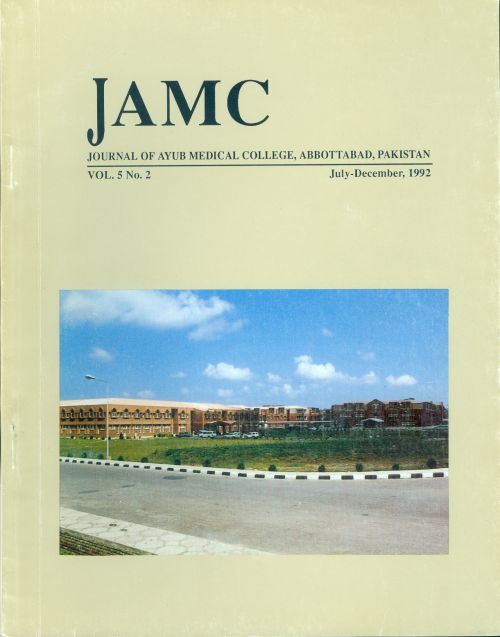TYPHOID PERFORATIONS - PROGNOSTIC FACTORS AND MODE OF TREATMENT
Abstract
ABSTRACT:This report examines the characteristics of 60 patients with typhoid perforations, treated over a
period of 7.5 years, ending September, 1990. The most important prognostic determinants were
perforation/operation interval, age of the patient and mode of treatment. 15% cases were treated
conservatively with 11.11% mortality, in 3% only a drainage procedure could be instituted with a
50% mortality and definitive treatment in the form of simple closure (in 54% cases), and wedge
resection (in 28% cases) yielded 22.5% and 18% mortality respectively.
References
Khanna, A.K., et at Typhoid perforation of gut. Post graduate Medical Journal, 1984; 60: 523-
Olurin, E.O., et at Typhoid Perforation. Journal of Royal College of Surgeons of Edinburgh,
; 17: 353 64.
Bohnen John, et at Prognosis in generalised peritonitis. Archives of Surgery, 1983; 118: 285.
Spencer, E.E., Efem, et at Recent advances in the management of Typhoid enteric perforation
in children. Journal of Royal College of Surgeons of Edinburgh, 1986; 31: 214-16.
Sitaram Venkatramani, et at Typhoid ideal perforation. Annal of Royal College of Surgeons of
England, 1990; 72:347-49.
Gen Ralph, et at Prognostic factors in generalized peritonitis. Journal of Royal College of
Surgeons of Edinburgh, 1979; 21 (3).
Henry, T., Randal, et at Manual of pre-operative and post-operative care. (By American College
of Surgeons) W.B. Saunder's Company Philadelphia and London, 1988; p.30.
Stephen, M. Generalized infective peritonitis. Surgery, Gynecology and Obstetrics, 78; 147:
-34.
Downloads
How to Cite
Issue
Section
License
Journal of Ayub Medical College, Abbottabad is an OPEN ACCESS JOURNAL which means that all content is FREELY available without charge to all users whether registered with the journal or not. The work published by J Ayub Med Coll Abbottabad is licensed and distributed under the creative commons License CC BY ND Attribution-NoDerivs. Material printed in this journal is OPEN to access, and are FREE for use in academic and research work with proper citation. J Ayub Med Coll Abbottabad accepts only original material for publication with the understanding that except for abstracts, no part of the data has been published or will be submitted for publication elsewhere before appearing in J Ayub Med Coll Abbottabad. The Editorial Board of J Ayub Med Coll Abbottabad makes every effort to ensure the accuracy and authenticity of material printed in J Ayub Med Coll Abbottabad. However, conclusions and statements expressed are views of the authors and do not reflect the opinion/policy of J Ayub Med Coll Abbottabad or the Editorial Board.
USERS are allowed to read, download, copy, distribute, print, search, or link to the full texts of the articles, or use them for any other lawful purpose, without asking prior permission from the publisher or the author. This is in accordance with the BOAI definition of open access.
AUTHORS retain the rights of free downloading/unlimited e-print of full text and sharing/disseminating the article without any restriction, by any means including twitter, scholarly collaboration networks such as ResearchGate, Academia.eu, and social media sites such as Twitter, LinkedIn, Google Scholar and any other professional or academic networking site.










